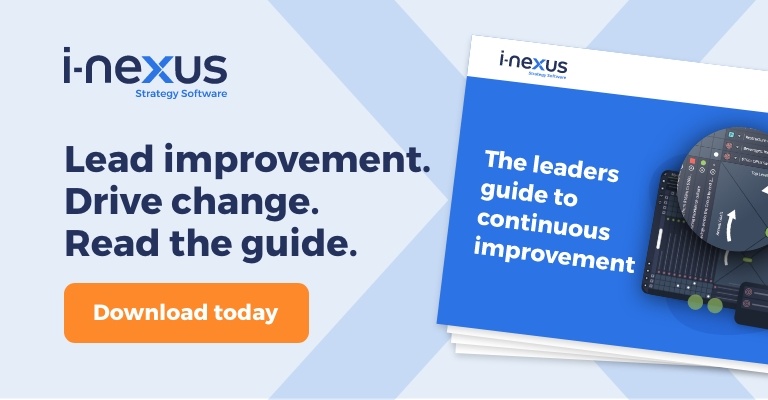While Continuous Process Development is a journey that involves everyone in the organization, leaders play a pivotal role in steering the course. Find out what you can do to create foundations for success.
While CPD is a journey that involves everyone in the organization, leaders play a pivotal role in steering the course.
In part three of our three-part Continuous Process Development series, we will delve into the critical role of leadership in CPD, explore the qualities that effective leaders possess, and provide practical insights to empower teams for a successful CPD journey.
Moreover, we'll highlight potential leadership pitfalls in CPD to help leaders navigate these challenges effectively.
And if you've not had a chance to read our first two parts, you can do so below:
Leadership is the cornerstone of Continuous Process Development?
Leadership isn't just about steering the ship; it's about building a robust vessel that can weather any storm.
In the context of CPD, leaders serve as architects, crafting an environment where continuous improvement thrives.
Here's why leadership is the cornerstone of CPD:
Setting the vision
Effective leaders provide a clear vision of what CPD means for the organization. They set goals and define the path forward, inspiring their teams to embrace the journey.
Resource allocation
Leaders ensure that teams have the resources they need for CPD initiatives. Effective leaders provide the support required for success, whether it's time, budget, or personnel.
Culture cultivation
A culture of continuous improvement begins with leaders. They must foster an environment where teams feel encouraged to voice their ideas, experiment with new solutions, and learn from their experiences.
Strategic alignment
Leaders bridge the gap between CPD efforts and the organization's strategic goals. They ensure that CPD initiatives are not isolated but are in sync with the broader mission.
Motivation and recognition
Leaders keep teams motivated by recognizing their contributions to CPD. Acknowledging and rewarding innovation and dedication are crucial for sustaining momentum.
The qualities of effective leaders in CPD
Now that we understand the significance of leadership, let's explore the qualities that make a leader effective in CPD:
-
Visionary perspective
Effective leaders envision how CPD can shape the organization's future. They see beyond the immediate improvements and inspire their teams to believe in the long-term benefits. -
Data-driven decision-making
Leaders in CPD rely on data and insights to make informed decisions. They ensure that data collection and analysis are integral to the improvement process. -
Empowerment
These leaders empower their teams to take ownership of CPD initiatives. They provide tools, training, and freedom to experiment, fostering a sense of responsibility. -
Open communication
Communication is the glue that holds CPD together. Effective leaders create an atmosphere where teams feel comfortable sharing ideas, reporting issues, and providing feedback. -
Adaptability
The landscape of CPD is ever-evolving. Effective leaders adapt to changes, learn from failures, and adjust strategies. They lead by example in embracing change.
Five ways to empower your teams
Creating a culture of continuous process improvement begins with leaders, but its success relies on the active involvement of every team member. Here's how leaders can empower their teams:
Provide training
Equip your teams with the skills and knowledge required for CPD. Training programs can be tailored to enhance problem-solving, data analysis, and process optimization skills.
Encourage idea-sharing
Foster a culture where every team member feels their ideas are valued. Regular brainstorming sessions and suggestion boxes are simple yet effective tools.`
Experimentation
Give your teams the freedom to experiment with new solutions. Tools like Trello can help manage and track experiments effectively.
Feedback mechanisms
Establish regular feedback loops where teams can review CPD progress and discuss challenges. Tools like i-nexus or Jira can facilitate this process.
Recognition
Recognize and reward contributions to CPD. Highlighting the positive impact on the organization and individual growth can boost motivation.
Real-world examples of leaders excelling in CPD
1. Sundar Pichai - Google
Sundar Pichai, the CEO of Google, encourages his teams to innovate continually. Under his leadership, Google remains at the forefront of technological advancements.
2. Tim Cook - Apple
A commitment to quality and innovation marks Tim Cook's leadership at Apple. Apple's focus on user experience and quality is an exemplar of CPD.
3. Mary Barra - General Motors
Mary Barra's leadership at General Motors is defined by embracing new technologies and continuous improvement. GM's dedication to sustainable practices is a testament to her leadership.
4. Satya Nadella - Microsoft
Satya Nadella's transformation of Microsoft is a prime example of effective CPD. The organization has embraced cloud services, AI, and a growth mindset.
Case study: Google
Sundar Pichai's journey at Google is a testament to his commitment to continuous innovation.
As the CEO of one of the world's most prominent technology companies, Pichai has played a pivotal role in shaping Google's approach to product development, technology advancements, and the future of the digital landscape.
Pichai has driven Google's mission to "organize the world's information and make it universally accessible and useful." His leadership philosophy centers on several key principles:
-
Customer-centric approach
Pichai understands the importance of listening to customers and addressing their needs. He encourages teams to develop products and services that benefit users, from search engine improvements to innovative software and hardware solutions. -
Inclusive innovation
Under Pichai's leadership, Google has embraced inclusivity in technology. Initiatives like Google's Accessibility team focus on developing technology that is accessible to all, including those with disabilities. Pichai champions the idea that innovation should not leave anyone behind. -
Data-Driven decision-making
Data is the backbone of Google's innovation process. Pichai emphasizes the value of data analysis in understanding user behavior and preferences. This data-driven approach guides decisions and ensures that innovations align with user needs. -
Moonshot projects
Pichai supports and leads "moonshot" projects like Google X and its self-driving car subsidiary Waymo. These ambitious ventures tackle the world's most significant challenges, pushing the boundaries of technology and innovation. -
Continuous learning
Pichai's leadership style encourages continuous learning and adaptation. Google's innovative culture is epitomized by the "20% time" concept, where employees are encouraged to spend a portion of their work hours on projects of their choice.
Originally introduced by Google, this concept has led to the development of some of Google's most iconic products, including Gmail. It aligns perfectly with the principles of continuous process development (CPD) by fostering creativity, experimentation, and learning.
Under Sundar Pichai's leadership, Google maintains its position at the forefront of technological advancements. Google's commitment to innovation extends beyond its core products and services, encompassing artificial intelligence, machine learning, cloud computing, and more.
The organization remains dedicated to discovering new ways to make technology accessible and beneficial to people worldwide.
Pichai's leadership, coupled with Google's "20% time" concept, is a prime example of how a visionary leader can drive an organization's commitment to continuous process development and innovation, making it a driving force in the ever-evolving technology landscape.
Avoiding common leadership pitfalls in CPD
Effective leadership is not without its challenges in CPD. It's essential to be aware of potential pitfalls and navigate them effectively:
Micromanagement
Avoid stifling creativity by micromanaging CPD initiatives. Trust your teams to execute and learn from their experiences.
Lack of communication
Failure to communicate the vision, goals, and progress can hinder CPD efforts. Keep the lines of communication open and transparent.
Resistance to change
Some team members may resist changes brought about by CPD. Communicating the benefits, involving them in decisions, and providing the necessary support and training is crucial.
Overemphasis on short-term gains
Effective leaders balance the short-term and long-term benefits of CPD. Overemphasizing immediate results can hinder sustainable improvements.
Ignoring data insights
In CPD, data is your guide. Ignoring data insights can lead to misguided decisions. Ensure data collection and analysis are prioritized.
Moving forward
With continuous process development, leaders are the compass guiding their organizations towards success.
By possessing essential qualities, empowering their teams, and steering clear of leadership pitfalls, they can create an environment where CPD thrives.
With inspiration from real-world leaders and a commitment to continuous improvement, organizations can ensure that CPD remains at the heart of their journey to excellence.
To learn more about how you can guide your team's efforts, download our leadership eBook:
Read more about operational excellence and related tools with our content below:
- Choosing between Lean vs. Six Sigma: which is right for you?: Lean and Six Sigma dominate conversations around continuous improvement - but how similar are they? Find out their differences and understand what fits your organization best with our guide.
- The ultimate continuous improvement jargon buster: Your guide to the many names, terms, acronyms, and phrases used when talking about delivering process improvement.
- 10 challenges facing the pharmaceutical industry in 2024: Pharmaceuticals are one of the most vital in the world, providing life-saving medicines and treatments to millions, but it's full of strategy execution challenges. Here's what that looks like.
About the author
James Milsom is Head of Marketing at i-nexus. As Head of Marketing, his drive is to raise awareness and understanding of the challenges facing enterprises in delivering strategic objectives and transformation amidst changing markets and the obstacles traditional tools and methods present leaders.
If you’d like to talk strategy, contact James at james.milsom@i-nexus.com or connect with him on LinkedIn for the latest insights.



